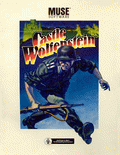
































Castle Wolfenstein

Castle Wolfenstein is an early stealth-based action-adventure shooter video game developed by Muse Software for the Apple II. It was first released in 1981 and later ported to MS-DOS, the Atari 8-bit family, and the Commodore 64.
Castle Wolfenstein is a stealth-based action-adventure shooter game set in World War II. The game's main objective is to traverse the levels of the castle to find the secret war plans and escape alive. Progressively higher military ranks are earned upon each successful escape with the war plans, and the game becomes correspondingly more difficult as each higher rank is achieved. There are eight ranks, beginning with Private, culminating at the rank of Field Marshal.
It combines adventure game elements with real-time action. The game is played from a top-down perspective, though the characters are seen upright like in a side-scroller. The player traverses the levels by sneaking past guards, impersonating Nazi soldiers and sometimes even killing opponents. Castle Wolfenstein can be controlled with a joystick, paddles, or a keyboard.
Upon starting the game, the player is equipped with a gun and ammunition, which were taken from a dead guard. Once the player starts moving, he attracts the attention of the guards, who will try to shoot or apprehend him. He must either run from the guards, or kill them.
There are two styles of guards, the basic guards, and the SS Stormtroopers who wear bullet-proof vests marked with the SS insignia. The basic guards are not very intelligent, reacting only to the sounds of gunshots and grenades, or after seeing the player wandering around without a uniform, and will gladly walk their patrol paths into your raised gun and surrender to a search. Additionally, they are unable to leave the rooms they are stationed in. The SS guards are much smarter and, once alerted, tend to chase the player from room to room. They require a large number of rounds or a grenade to kill.
The player has two means of killing enemies. The first is to shoot the enemy, but this expends ammunition, a scarce commodity, and risks raising the alarm if another guard is present. Alternatively, a grenade can be used, though this will also attract the attention of nearby guards. Once an enemy soldier is dispatched, his body can be searched for ammunition, keys, grenades and bullet-proof vests. The player will only take as many rounds of ammunition and grenades as he can carry from the body, leaving the remainder.
An alternative to the player shooting his way out of the castle is to find a uniform (either in a chest or from a dead guard), at which point the normal guards will think the player is one of them. However, the SS guards will usually expose the player as an impostor.
Guards do not always have to be killed. Pulling a gun on a guard usually will cause him to put his hands up, allowing him to be frisked for ammo, bullet-proof vests, grenades, and keys, depriving the guard of the full quantity of these he carries. Any in excess of the player's carrying capacity disappear from the game. The player can still choose to kill the guard at this point, but it is not strictly necessary.
Some rooms contain locked chests that can be picked and searched. Some are empty, but others contain useful items such as bullets, grenades, uniforms, bullet-proof vests and the war plans. Chests can also contain bratwurst, Liebfraumilch wine, Schnapps, Eva Braun's Diaries, cannonballs, and medals, though all are worthless in gameplay. Edible items, when ingested, result in comments on their flavor. After drinking an alcoholic beverage, a message of 'Hic!' is displayed on screen and the player's aim is temporarily thrown off balance, resulting in bullets and grenades missing their target.
There are a total of 60 discrete rooms in the castle, on five separate floors. Although the rooms are shuffled at the beginning of each game, the path through the castle always remains unchanged. Therefore, it is possible to fully map the castle, and then utilize the map during subsequent games.
Other than the outer walls of the room and the stairs, the entire room is destructible using grenades. This can be necessary in order to access a chest from another direction if a body has fallen in front of it: searching a body has precedence over opening a locked chest. Chests can also be destroyed with a grenade, but if the chest contains explosives (bullets, grenades, or cannonballs) it will explode and end the game. Chests can also be shot open, but attempting to do so also risks setting off any explosive contents.
Running straight into walls temporarily stuns the player, but vertical walls can be clipped slightly by the player's motion and not stun him. Also, some horizontal walls can be walked into from the side without effect. Fallen dead guards can also allow the player to walk through horizontal wall segments and chests, albeit not from directly below. Surviving guards and SS will not walk over bodies, so they can be used to block passage to areas of the room, trap guards in cul-de-sacs, as well as block entrance by the SS into rooms.
One of the main drawing points for fans was its unprecedented use of digitized voices. German words shouted by the guards, such as 'Halt!' (stop!) and 'Kommen Sie!' (come, you!) were frequent. Though limitations in technology only allowed for a few distorted shouts, the voices added to the game's atmosphere and made Castle Wolfenstein stand out from other games released at the time.
With an emphasis on trying to avoid detection for as long as possible, Castle Wolfenstein and its sequel are considered by gamers to be prototypical stealth-based games—some of the first in a genre that wouldn't gain popularity until the late 1990s.
How to play:
Click on the joystick icon in the Castle Wolfenstein online emulator to see how to control the Castle Wolfenstein game









































Comments